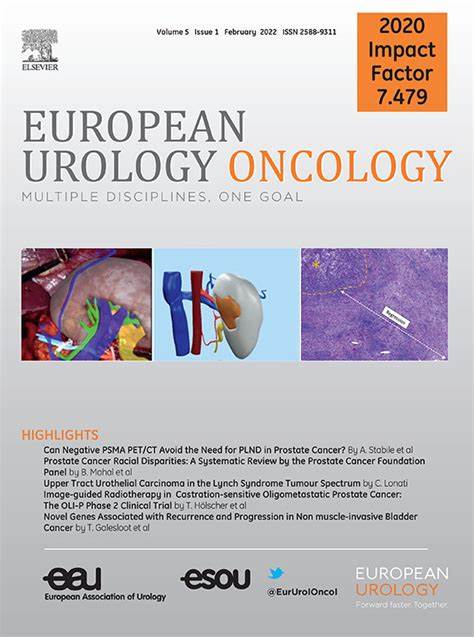随机接受雄激素剥夺+恩杂鲁胺±唑来膦酸治疗的转移性激素敏感前列腺癌患者体成分的总体和局部变化。博恩扎研究。
IF 9.3
1区 医学
Q1 ONCOLOGY
引用次数: 0
摘要
背景与目的:众所周知,雄激素剥夺治疗(ADT)导致前列腺癌患者瘦体质量(LBM)的降低和脂肪体质量(FBM)的增加会导致肌肉减少症的风险增加。ADT中加入雄激素受体途径抑制剂(arpi)对机体成分的影响尚未得到深入研究。方法:BONENZA (NCT03336983)是一项前瞻性2期试验,在该试验中,转移性激素敏感前列腺癌患者随机接受ADT加恩杂鲁胺(EZ组)或不加唑来磷酸(E组)。在基线和治疗18个月后,通过双能x线吸收仪(DXA)扫描评估总体和局部身体成分参数。主要发现和局限性:89例患者(46例来自EZ组,43例来自E组)在两个时间点进行了配对DXA评估。治疗18个月后,FBM增加了+22.8% (p 40.8%), 3.5%的患者有ALMI:结论和临床意义:随着arpi加入ADT,体成分发生了显著变化,FBM增加,LBM减少,这是单独ADT预期的两倍。DXA已被证明是监测身体成分的可靠工具,对地区差异的评估有助于实施个人监督的体育锻炼,以预防肌肉减少性肥胖的风险。本文章由计算机程序翻译,如有差异,请以英文原文为准。
Total and Regional Changes in Body Composition in Metastatic Hormone-sensitive Prostate Cancer Patients Randomized to Receive Androgen Deprivation + Enzalutamide ± Zoledronic Acid. The BONENZA Study
Background and objective
The reduction of lean body mass (LBM) and the increase of fat body mass (FBM) caused by androgen deprivation therapy (ADT) administered to prostate cancer patients are well known to lead to an increased risk of sarcopenia. The effects of the addition of androgen receptor pathway inhibitors (ARPIs) to ADT on body composition have not been studied thoroughly.
Methods
BONENZA (NCT03336983) is a prospective phase 2 trial in which metastatic hormone-sensitive prostate cancer patients were randomized to receive ADT plus enzalutamide with (EZ arm) or without (E arm) the addition of zoledronic acid. Total and regional body composition parameters were evaluated by dual-energy x-ray absorptiometry (DXA) scans at baseline and after 18 mo of therapy.
Key findings and limitations
Eighty-nine patients (46 from the EZ arm and 43 from the E arm) had paired DXA evaluation at both time points. After 18 mo of therapy, FBM increased by +22.8% (p < 0.001), LBM reduced by –6.7% (p < 0.001), and appendicular lean mass index (ALMI) decreased by –9.2% (p < 0.001). The increase in FBM varied considerably according to body districts: from +36.1% in the right arms (p < 0.001) to +3.7% in the head (p < 0.01). Similarly, the decrease in LBM ranged from –9.4% (p < 0.001) in the right arm to –6.4% (p < 0.001) in the trunk. None of the patients met the criteria for sarcopenic obesity; however, after 18 mo of treatment, 11.76% of patients had FBM >40.8%, 3.5% of patients had an ALMI of <5.5, and the ALMI/FBM ratio decreased by –23.9% (p < 0.001). Age and baseline LBM influenced these body composition changes significantly, with younger patients (<70 yr) and those with higher baseline LBM experiencing more marked changes.
Conclusions and clinical implications
Body composition undergoes a significant change with the addition of ARPIs to ADT, with an increase in FBM and a reduction in LBM, which are twice as high as those expected with ADT alone. DXA has been proved to be a reliable tool for monitoring body composition, and an assessment of district variations can aid in implementing individual-supervised physical exercise to prevent the risk of sarcopenic obesity.
求助全文
通过发布文献求助,成功后即可免费获取论文全文。
去求助
来源期刊

European urology oncology
Multiple-
CiteScore
15.50
自引率
2.40%
发文量
128
审稿时长
20 days
期刊介绍:
Journal Name: European Urology Oncology
Affiliation: Official Journal of the European Association of Urology
Focus:
First official publication of the EAU fully devoted to the study of genitourinary malignancies
Aims to deliver high-quality research
Content:
Includes original articles, opinion piece editorials, and invited reviews
Covers clinical, basic, and translational research
Publication Frequency: Six times a year in electronic format
 求助内容:
求助内容: 应助结果提醒方式:
应助结果提醒方式:


